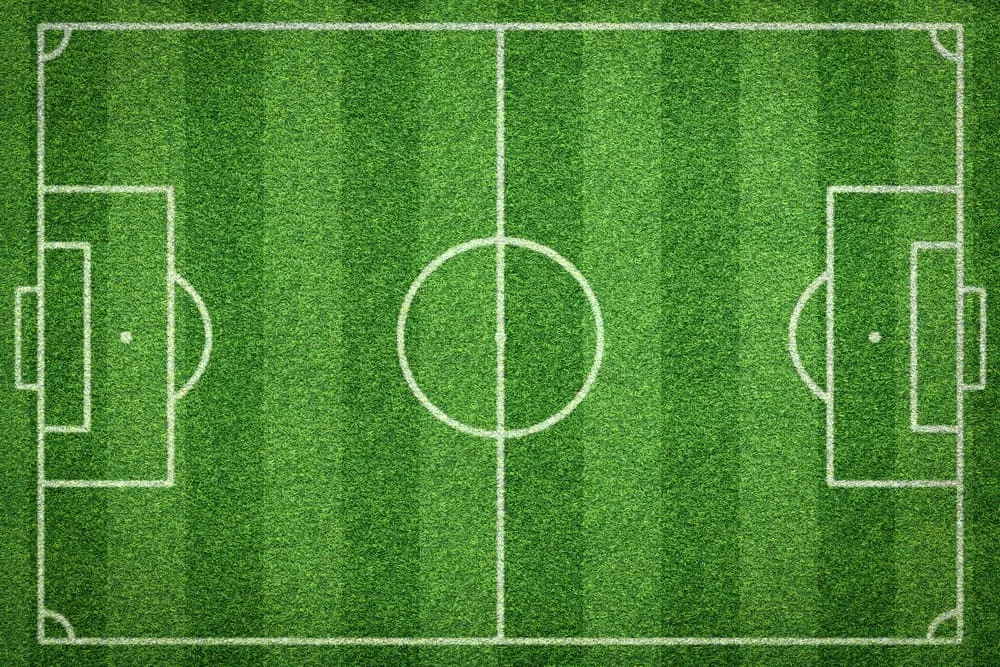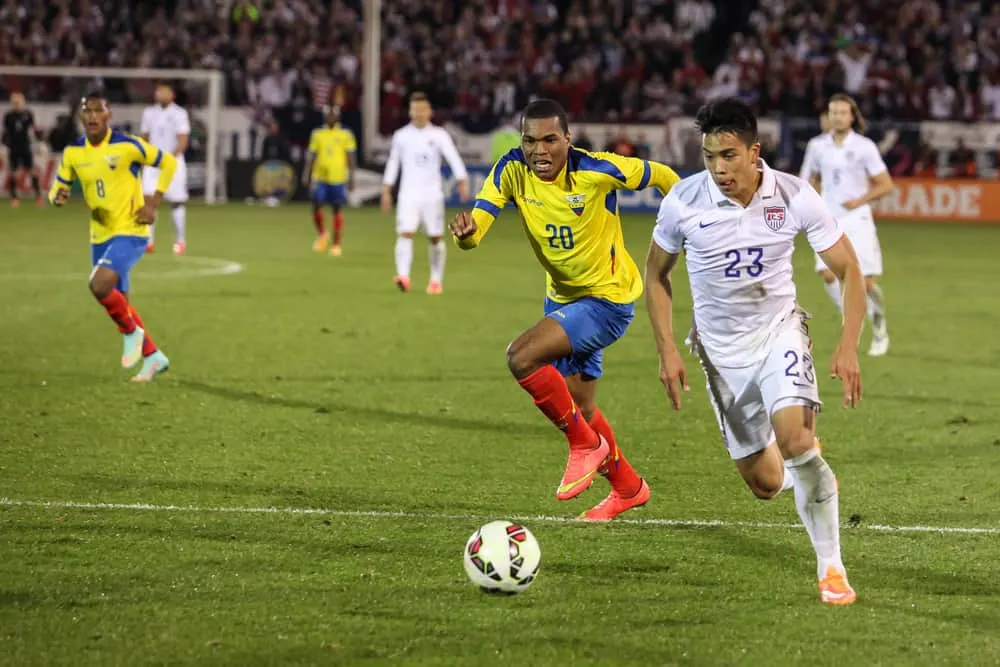
For as popular as the sport of soccer is around the world, one common question many people have is just how big a soccer field is. Unlike many sports, not everything is as formal as a person might think, even at the highest levels.
What is the size of a soccer field? FIFA officially has a wide range of pitch sizes, as they can be anywhere from 90 meters to 120 meters in length, and 45 meters to 90 meters in width. The size of the penalty boxes, goal areas, and the actual goal is all uniform.
Is There a Standard Pitch Size?

Just about every pitch is slightly different, but a common measurement is 105 meter in length, and 68 meters in widith. Teams such as Manchester United, Manchester City, Arsenal, Barcelona, and many other clubs use this size currently.
It is rare to see the length of the pitch go below 100 meters anywhere, or the width to go below 60 meters. The only clubs that use this size consistently are lower levels that might be forced to with the layout of their stadium.
Additional Measurements On a Soccer Field
The length and width of the field might vary, but some measurements do not change at all. On any professional soccer pitch, certain lines are all the same.
- The center circle is a 10-yard radius on every single adult pitch. It is put in the middle of the field, and there is a halfway line across the field that divides everything up. It goes right through the center circle.
- The penalty area is a box that is 16.5 meters long, and 40.3 meters wide. It is centered on the pitch, depending on the overall width. It is important to have a universal size for the penalty box since so much action goes on there throughout a match.
- A regulation soccer goal has the official size of 24 feet (7.3 meters) by 8 feet (2.4 meters). Again, if goals changed size from pitch to pitch, it would be a mess for goalies trying to perfect how to play their position.
Some of the lesser-known lines on a field is the four-yard arc at the top of the penalty area, plus one-yard arcs in all four corners for penalty kicks. The penalty spot is located 11 meters (12 yards) from the back of each goal.
One of the more confusing things about field dimensions is that some of them are clearly based off of the metric system, while others use the imperial system. While there is a way to convert easily, it makes it a little more confusing to memorize all of the measurements.
How Much Do Field Sizes Change For Younger Players?

Everything on the soccer pitch shrinks to a certain degree for younger players. There are no uniform rules as far as how big pitches need to be for certain ages or even goal sizes for that matter.
A lot of leagues will use their own dimensions, but they do try to keep everything proportional to a larger field. The purpose of shrinking the field is to not only make it easier for players running around but to even the playing field as well.
At younger levels, teams that have a lot of speed can crush opponents when they have space to work with. By packing things in a bit more, it makes everything a little more competitive for varying skill levels.
Once players get to the high school level, pitch sizes in some cases are dependent on other sports. Most notably, in the United States, soccer teams usually share their field with the football team. Since the majority of stadiums are built for football, the soccer field must fit.
This makes them A little smaller than a professional pitch in most cases, but the difference is not that crazy.
You can learn more about youth soccer field dimensions here.
Can Clubs Use Their Pitch Size As An Advantage?

In all types of sports, there is such a thing as a home-field advantage. In soccer, it can be a pretty big benefit for certain teams if they put in enough effort to tailor to their team.
Field dimensions obviously play a pretty big role in dictating how the team plays. Teams that do not have a lot of speed benefit from having a smaller field. They do not have as much ground to cover. It not only helps with keeping up with the opposition but they stay a bit more fresh.
While a bigger field can allow fast teams to maximize their ability to create space and tire out there having more opportunity to move around is a huge positive for teams as they try to wear their opponents down as much as possible.
It makes a lot of sense for teams to adjust to their pitch in some cases, but some will actually adjust their pitch according to the current iteration of the team. That might only be possible for clubs with a lot of money to work with, but it has happened in some leagues.
Will Soccer Ever Have a Truly Uniform Field?
Some fans would like to see a truly uniform size, while others like how there is a bit of uniqueness to every home pitch. If they have not changed it to this point, chances are they are going to be just fine leaving it as is.
One great thing about allowing different field dimensions is that it makes the sport a little more willing to accept people and teams from anywhere. There is no need to be exact with a field and its size. Most players do not notice a few meters here in there anyway, so it works out for them as well.
The Slope Of a Soccer Pitch
With so much focus on the different dimensions of a soccer field, one thing to also point out is that pitch is at a particular slope in almost every case. This is done mostly because of drainage, but it can also play a factor in helping out individual teams. For example, if the field is sloped towards one end of the pitch, it can be an advantage for a home club to play the second half going downhill. Meanwhile, the opposition finds it just a bit more challenging to score with tired legs.
A little less unconventional at some levels is the fact that there are parts of a field that have uneven terrain as well. Maybe the club does not have enough money to level the playing field as much as possible, and they have to work with what they have in general.
All of this can play a part in a home-field advantage along with the dimensions of the pitch itself. It might not appear to be much of a factor when observing the game in person or on television, but the players do feel it a bit.
Do Different Soccer Dimensions Make a Difference?
If a field feels a little shorter than usual, or it does not have quite the same amount of width, it might not seem like that big of a deal to a fan. Players might not notice either unless it is a drastic difference overall. Most great teams can adapt just fine, but when looking for any type of edge, some teams feel like it does make a difference.
What is pretty unique is that no two fields are exactly alike. The sport can feel a little boring if everything looks and feels the same, so having some uniqueness to it like baseball stadiums as another example is a nice twist for players and fans.
